文章信息
- 邓丛静, 马欢欢, 王亮才, 朱正祥, 周建斌.
- Deng Congjing, Ma Huanhuan, Wang Liangcai, Zhu Zhengxiang, Zhou Jianbin.
- 杏壳半纤维素的结构表征与热解产物特性
- Structure Characterization and Pyrolysis Properties of Apricot Shell Hemicellulose
- 林业科学, 2019, 55(1): 74-80.
- Scientia Silvae Sinicae, 2019, 55(1): 74-80.
- DOI: 10.11707/j.1001-7488.20190109
-
文章历史
- 收稿日期:2017-11-30
- 修回日期:2018-04-01
-
作者相关文章
2. 南京林业大学材料科学与工程学院 南京 210037
2. College of Materials Science and Engineering, Nanjing Forestry University Nanjing 210037
山杏(Prunus armeniaca)是我国北方干旱和半干旱地区重要的生态经济型树种,种植总面积约267万hm2,年产杏仁量约20万t;杏壳是杏仁深加工过程中产生的下脚料,年产量40万~50万t(刘晓光等,2017)。杏壳是热解活化制备果壳活性炭的重要原料(Khan et al., 2018;Yang et al., 2015;孙康等,2017),在热解活化过程中,半纤维素是最易热分解的组分,因此需要建立热解半纤维素主要产物的形成路线,以了解其内在裂解机制,控制热分解过程,制成高附加值的产品和副产物的综合利用(Xu et al., 2006;Yuan et al., 2010)。
半纤维素是由2种或2种以上单糖组成的不均一聚糖,其基本糖单元主要有木糖、甘露糖、半乳糖和阿拉伯糖等,在生物质中占15%~30%(彭红等,2012)。半纤维素分离一般利用不同浓度碱液与某些助剂的共同作用或某种有机溶剂的单独作用,将不同聚糖抽提出来并加以分离(Fang et al., 2000;许凤等,2005),其中生物质热化学利用是生物质能源的重要转化方式,热重-红外联用分析技术以其快速灵敏和实时分析等优点,被广泛应用于生物质热裂解特性研究中。
生物质组分分布多样性使其热解时发生的化学反应非常复杂(Zhang et al., 2013;胡亿明等,2014;蒋新元等,2015),因此对半纤维素的热解行为进行单独研究十分重要。彭云云等(2009)利用KOH溶液处理蔗渣综纤维素后得到蔗渣半纤维素,研究了其热解动力学和热解气态小分子产物。Shen等(2010)利用TG-FTIR研究硬木中半纤维素的热解机制和主要气态产物成分,探讨了CO、CO2、CH4、H2的形成路径过程。黄金保等(2016)利用4-O-甲基葡萄糖醛酸作为半纤维素模型化合物进行热解研究,提出了6种可能的反应路径,并对各种反应路径中反应物、产物、中间体和过渡态的结构进行了几何结构全优化。但杏壳半纤维素的分离制备、组成结构、微观形态以及热解规律尚未有系统研究。
鉴于此,本研究利用化学方法从杏壳原料中分离出杏壳半纤维素,并采用红外光谱、核磁共振、扫描电子显微镜对其结构组成和微观形貌进行表征,利用热重分析和热重红外连用分析考察其在不同温度段的热解挥发性产物及产物生成规律,以期为杏壳热化学利用提供理论基础。
1 材料与方法 1.1 试验原料杏壳原料由河北承德华净活性炭有限公司提供,破碎后筛分选取粒径在40~60目(0.250~ 0.425 mm)之间的样品,105 ℃下鼓风干燥至恒重。杏壳原料的工业分析与元素分析见表 1。
|
|
取杏壳原料8 g,依次加入蒸馏水260 mL、亚氯酸钠3 g、乙酸2 mL,75 ℃下振荡1 h,立即置于冰水中冷却,用G1玻璃砂芯漏斗过滤,去离子水洗涤至中性,再用丙酮将原料清洗3遍后放入通风橱,待丙酮挥发完全后置于低温烘箱干燥至恒重,即得到综纤维素。
1.2.2 杏壳半纤维素的制备在20 ℃下,用17%氢氧化钠溶液抽提杏壳综纤维素2 h,过滤。用浓度6 mol·L-1乙酸中和至pH为5.5,加入95%乙醇溶液使半纤维素充分沉淀,离心过滤,冷冻干燥,即得到杏壳半纤维素,得率为29.44%。
1.3 分析表征方法 1.3.1 红外光谱分析(FTIR)取1 mg干燥杏壳半纤维素与100 mg溴化钾在玛瑙研钵中混合,研磨至粒径 < 0.071 mm后,采用溴化钾压片法制样,在美国Thermo Nicolet公司傅里叶变换红外光谱仪上进行分析,扫描范围为4 000~500 cm-1。
1.3.2 核磁共振分析(1H-NMR)准确称取60 mg杏壳半纤维素样品,将其充分溶解于2 mL重水和0.6 mL氘氧化钠溶液中,溶解后的样品在瑞士布鲁克拜厄斯宾(Bruker Biospin)公司AVANCEⅢ 600 MHz全数字化超导核磁共振谱仪上进行检测,条件为:温度30 ℃,30°脉冲,脉冲宽度41.6 μs,采样时间2.7 s。
1.3.3 扫描电子显微镜分析(SEM)干燥杏壳半纤维素样品经压片、喷金处理后,利用日本株式会社JSM-7600F型场发射扫描电子显微镜扫描,采用二次电子成像,工作距离为19.8 mm,加速电压为10 kV,分别观察不同放大倍数下样品表面形貌的变化情况。
1.3.4 热重分析热重分析在日本岛津公司DTG60 A型热重分析仪上进行,以α-Al2O3为参照物,以氮气为载气,流速为50 mL·min-1。准确称取干燥试样置于陶瓷坩埚中,以20 ℃·min-1的升温速率从室温加热至800 ℃,系统自动采集数据,得到质量变化与温度,经处理得到失重速率。
1.3.5 热重红外联用分析热重分析采用美国TA Instruments公司TGA Q5000型热重分析仪,每次试验用样15 mg,载气为氮气,流速70 mL·min-1。红外分析采用美国Thermo Fisher Scientific公司Nicolet6700型红外分析仪,波数4 000~400 cm-1,分辨率4 cm-1,每次扫描时间8 s,全光谱谱库检索。试验以20 ℃·min-1的升温速率从室温加热至800 ℃,试验结束后,热重分析仪自动降温,继续吹入氮气30 min以上。
2 结果与分析 2.1 红外光谱分析由图 1和表 2可知,半纤维素糖环特征吸收峰主要集中在600~1 620 cm-1范围内,1 045、3 421 cm-1分别为糖单元中C—O—C伸缩振动峰和羟基伸缩振动峰,均为半纤维素结构的特征吸收峰,897 cm-1处为C-1基团频率振动和环频率振动吸收峰,表明糖单元之间以β-糖苷键连接,990 cm-1处弱吸收带属于木糖残留物C-3位的阿拉伯糖取代位,即一个典型的取代阿拉伯木聚糖特征吸收峰,1 163 cm-1处的弱吸收峰表明存在阿拉伯糖基侧链,1 000~1 170 cm-1处的谱带为木聚糖的典型吸收峰,表明半纤维素成分以吡喃环结构的木糖为主(Sun et al., 2004)。
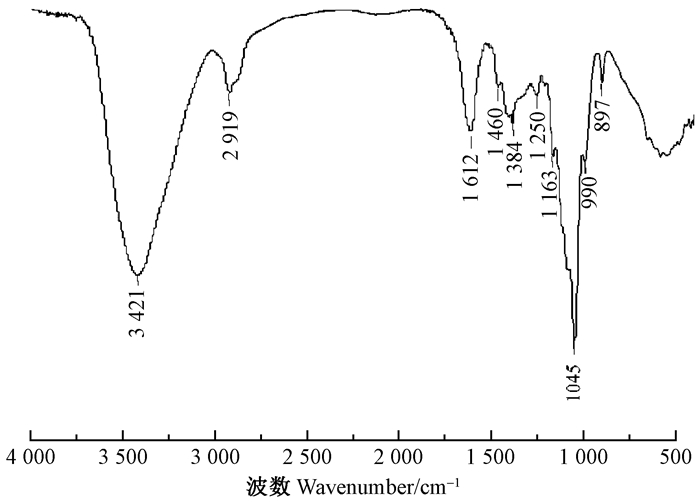
|
图 1 杏壳半纤维素的红外光谱 Fig. 1 FTIR spectra of apricot shell's hemicellulose |
|
|
杏壳半纤维素与果壳类及其他木质类在含量、提取方法和结构上的差别见表 3。
|
|
从表 3可以看出,杏壳中半纤维含量高于大部分果壳和秸秆等,但在结构上差异较小。
2.2 核磁共振分析对杏壳半纤维素1H-NMR谱(图 2、表 4)各吸收峰分析可知,3.06~5.43 ppm区域的信号为L-呋喃阿拉伯糖、D-吡喃木糖及4-O-甲基-α-D-葡萄糖醛酸的质子吸收峰,5.43 ppm为连接在木糖C-3位上的阿拉伯糖(H-1)的吸收峰,4.26 ppm(H-1)、3.85 ppm(H-5)、3.80 ppm(H-4)、3.42 ppm(H-3)和3.17 ppm(H-2)分别为D-吡喃木糖的吸收峰,3.51 ppm(H-2)为4-O-甲基-α-D-葡萄糖醛酸的信号峰,这说明杏壳半纤维素是以β-D-吡喃木糖形成的木聚糖为主链,在木糖基的C-2位连接4-O-甲基-α-D-葡萄糖醛酸,C-3位连有α-L-呋喃阿拉伯糖(Peng et al., 2010;Shen et al., 2009)。
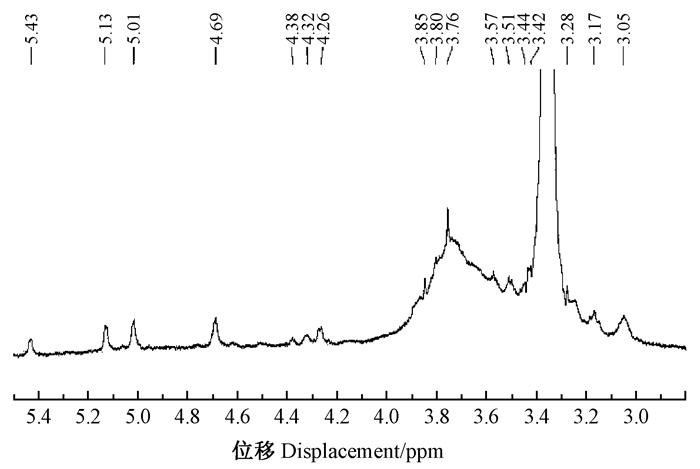
|
图 2 杏壳半纤维素的1H-NMR谱 Fig. 2 1H-NMR spectrogram of apricot shell's hemicelluloses |
|
|
由图 3可知,杏壳半纤维素的微观形态呈堆砌状的近似球形结构,这说明在纤维素分离时,乙醇纯化后半纤维素主链结构有一定破坏,支链变多。余紫苹(2012)从对毛竹(Phyllostachys edulis)中分离出的毛竹半纤维素进行研究发现,外观大多为不规则的长柱形状,附着少量絮状结构,随着乙醇浓度增加,其半纤维素主链越短、支链越多,外观也呈现出偏向球状。

|
图 3 杏壳半纤维素SEM Fig. 3 The SEM of apricot shell's hemicellulose |
在升温速率为20 ℃·min-1的条件下,杏壳半纤维素从室温升至800 ℃的TG和DTG曲线如图 4所示。杏壳半纤维素的主要热解温度在210~380 ℃之间,180 ℃以前只发生脱水失重,180 ℃左右开始分解,在240 ℃出现一个肩状峰,紧接着在308 ℃出现最大失重尖峰,失重过程在600 ℃左右结束。
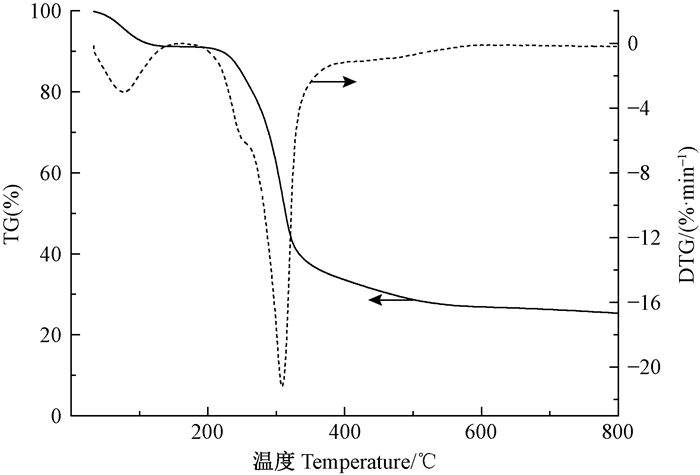
|
图 4 杏壳半纤维素的TG和DTG曲线 Fig. 4 TG and DTG curves of apricot shell's hemicelluloses |
杏壳半纤维素的热解过程分为4个阶段:第1阶段从室温升温至180 ℃左右,为半纤维素受热失水;第2阶段为200~280 ℃,杏壳半纤维素发生缓慢解聚,对应DTG曲线的第一个肩峰;第3阶段为280~380 ℃,是杏壳半纤维素热解的主要反应阶段,第2、3阶段的总失重率为80%;第4阶段为380 ℃以上,为煅烧阶段,失重逐渐趋于平缓,是C—C键和C—H键进一步破解所造成的,在800 ℃时热解残炭量为25.33%。该结果与王树荣等(2006)以木聚糖为半纤维模化物热解经历3个阶段大致相似,其最大热解失重速率发生在323 ℃,杏壳半纤维素的失重速率在308 ℃达到最大值,比木聚糖略低。
2.5 热重红外联用分析图 5所示为杏壳半纤维素在升温速率为20 ℃·min-1时热解挥发性产物的三维红外图谱。以波数为横坐标看,在2 400~2 260 cm-1处有一个显著的吸收尖峰,与图 4杏壳半纤维素热解DTG曲线的失重规律相互对应。以温度为横坐标看,挥发性产物吸收峰集中在260~400 ℃之间,与图 4杏壳半纤维素热解TG曲线吻合。
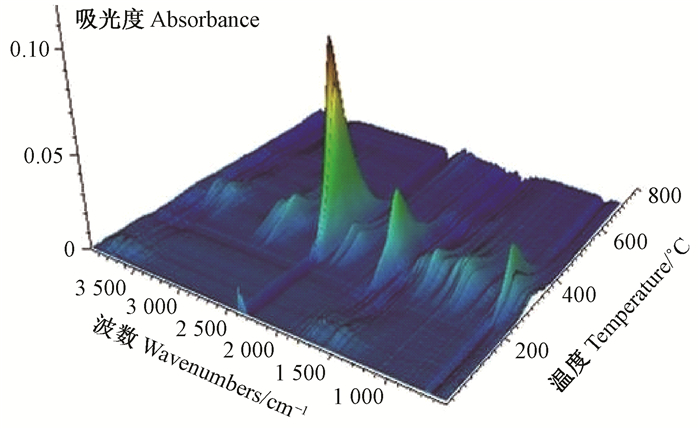
|
图 5 杏壳半纤维素热解挥发性产物的三维FTIR Fig. 5 Typical 3D-FTIR of volatile components from apricot shell's hemicellulose pyrolysis |
图 6所示为杏壳半纤维素热解时挥发性产物随温度变化(分别取250、310、370和400 ℃时4个温度)的红外图谱。根据特征吸收峰推测,热解挥发性产物的成分与杏壳相同,各产物析出量在310 ℃时达到最高。以热解失重最大热解温度为310 ℃处为例,根据特征吸收峰推测挥发性产物的组成:3 800~ 3 500 cm-1处对应H2O吸收峰;3 000~ 2 700 cm-1处对应CH4吸收峰;2 400~2 260 cm-1和720~580 cm-1处对应CO2;2 250~2 200 cm-1处对应CO吸收峰;1 900~1 650 cm-1处可能的化合物是醛类、酮类、酸类物质;1 690~1 450 cm-1处为芳香族化合物;1 475~1 000 cm-1处可能的化合物是烷烃、醇类、酚类、醚类及酯类物质(Hu et al., 2013;王霏等,2016;石峰等,2017)。
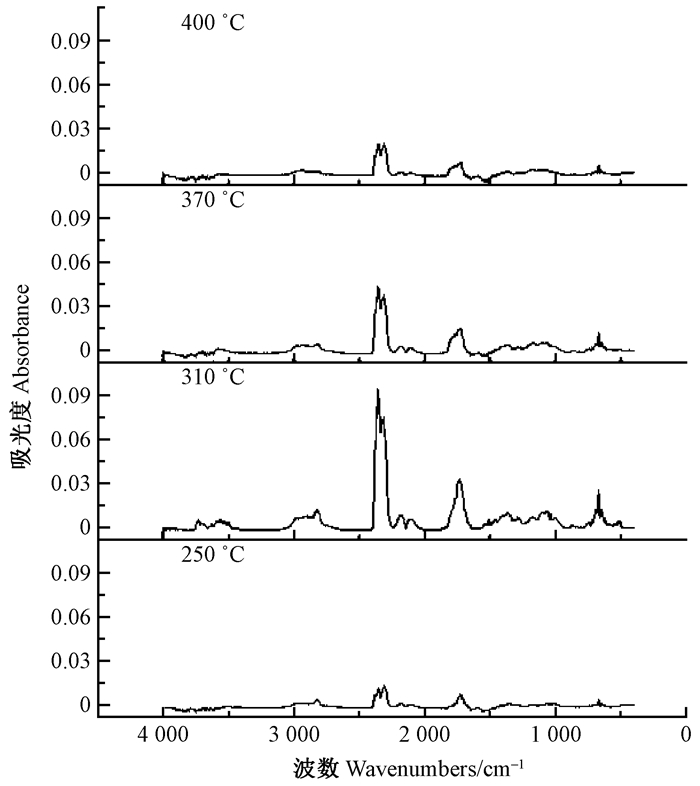
|
图 6 杏壳半纤维素不同温度下热解挥发性产物的红外图谱 Fig. 6 FTIR of the volatile components from apricot shell's hemicellulose pyrolysis at different temperatures |
杏壳半纤维素热解时各挥发性产物含量随温度的变化曲线如图 7所示。可以看出,半纤维素热解产生的小分子气体产物主要有CO2、CO、CH4,且CO2量远高于其他组分,CO2的生成主要与O-乙酰基生成的乙酸和4-O-甲基葡萄糖醛酸的脱羧基反应有关。CO产量随热解温度升高逐渐增加,这是因为在较低温度下,CO可由O-乙酰基木聚糖单元分解和4-O甲基葡萄糖醛酸的侧链结构脱除以及初始反应后生成碎片(乙醇酸、乙醛和甲醛)的脱羰基作用生成,而随着反应温度升高,热解二次反应中开环反应和一次热解产物脱羰基加剧,使得CO产量增加。半纤维素热解其他典型产物主要有乙酸、糠醛、丙酮、1-羟基-2-丙酮等小分子产物(Ponder et al., 1991)。
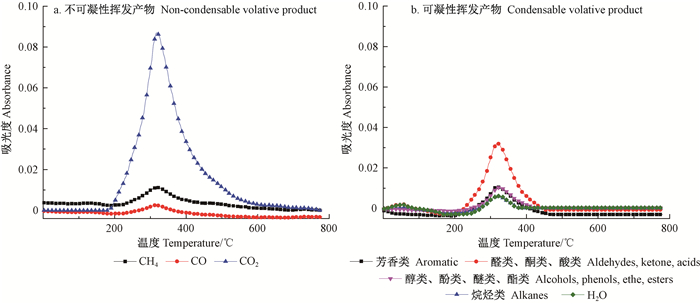
|
图 7 杏壳半纤维素热解挥发性产物随温度的变化 Fig. 7 The curve of volatile components from apricot shell's hemicellulose with temperatures increased |
本研究采用碱抽提和乙醇纯化方式从杏壳中分离出半纤维素的得率为29.44%,高于大部分果壳和秸秆。红外光谱分析表明杏壳半纤维素是以吡喃环结构的木糖为主,与其他生物质在结构上差异较小(Sun et al., 2004)。1H-NMR分析表明杏壳半纤维素是以β-D-吡喃木糖形成的木聚糖为主链,在木糖基的C-2位连接4-O-甲基-α-D-葡萄糖醛酸,C-3位连有α-L-呋喃阿拉伯糖(Peng et al., 2010;Shen et al., 2009)。杏壳半纤维素的微观形态呈堆砌状的近似球形结构,半纤维素结构有一定破坏,而毛竹半纤维素其微观大多呈不规则的长柱形状,附着少量絮状结构(余紫苹,2012)。
杏壳半纤维素的热解失重过程主要发生在260~400 ℃之间,失重速率在308 ℃达到最大值,挥发性产物在2 400~2 260 cm-1处有一个显著的吸收尖峰,而以木聚糖为半纤维模化物热解过程与杏壳半纤维素相似,热解失重速率发生在323 ℃,比杏壳纤维素略高(王树荣等,2006)。根据杏壳半纤维素热解时挥发性产物的红外图谱可知其组成主要有不可凝性(CO2、CO、CH4等)和可凝性(醛类、酮类、酸类、烷烃、醇类、酚类、醚类、酯类、芳香族)化合物(Hu et al., 2013;石峰等,2017)。杏壳半纤维素中O-乙酰基热解生成的乙酸和4-O-甲基葡萄糖醛酸的脱羧基反应产生的CO2远高于其他组分含量(王霏等,2016)。
4 结论本研究采用碱抽提和乙醇纯化方式从杏壳中分离出杏壳半纤维素,得率为29.44%,其结构是以β-D-吡喃木糖形成的木聚糖为主链,在木糖基的C-2位连接4-O-甲基-α-D-葡萄糖醛酸,C-3位连有α-L-呋喃阿拉伯糖,微观形态呈堆砌状的近似球形结构,含量略高于其他果壳及秸秆等生物质。杏壳半纤维素的主要热解温度范围为210~380 ℃,在308 ℃热失重最突出,在400 ℃左右失重趋于平缓,在600 ℃左右结束,800 ℃时热解残炭量为25.33%。杏壳半纤维素热解产物析出量在310 ℃时达到最高,小分子气体产物主要有H2O、CO2、CO、CH4,其中CO2含量最高。
胡亿明, 蒋剑春, 孙云娟, 等. 2014. 纤维素与半纤维素热解过程的相互影响. 林产化学与工业, 34(4): 1-8. (Hu Y M, Jiang J C, Sun Y J, et al. 2014. Interaction during the pyrolysis process of cellulose and hemicellulose. Chemistry and Industry of Forest Products, 34(4): 1-8. [in Chinese]) |
黄金保, 吴隆琴, 童红, 等. 2016. 半纤维素模型化合物热解机理的理论研究. 燃料化学学报, 44(8): 911-920. (Huang J B, Wu L Q, Tong H, et al. 2016. Theoretical study on thermal degradation mechanism of hemicellulose model compound. Journal of Fuel Chemistry and Technology, 44(8): 911-920. DOI:10.3969/j.issn.0253-2409.2016.08.003 [in Chinese]) |
蒋新元, 廖媛媛, 郭忠, 等. 2015. 7种果壳的热解特性及与主要组分相关性分析. 林业科学, 51(12): 79-86. (Jiang X Y, Liao Y Y, Guo Z, et al. 2015. Pyrolysis characteristics and correlation analysis with the major components of seven kinds of nutshell. Scientia Silvae Sinicae, 51(12): 79-86. [in Chinese]) |
刘晓光, 徐兆翮, 彭艳芳, 等. 2017. 承德山杏产业现状、存在问题及发展对策. 北方园艺, (6): 185-189. (Liu X G, Xu Z H, Peng Y F, et al. 2017. Status, problems and development countermeasures of Prunus armeniaca industry in Chengde city. Northern Horticulture, (6): 185-189. [in Chinese]) |
彭红, 胡铮瑢, 余紫苹, 等. 2012. 超声波辅助碱分离毛竹半纤维素. 农业工程学报, 28(9): 250-256. (Peng H, Hu Z R, Yu Z P, et al. 2012. Extraction of hemicelluloses from bamboo with ultrasound-assisted alkaline. Transactions of the Chinese Society of Agricultural Engineering, 28(9): 250-256. [in Chinese]) |
彭云云, 武书彬. 2009. TG-FTIR联用研究半纤维素的热裂解特性. 化工进展, 28(8): 1478-1484. (Peng Y Y, Wu S B. 2009. Characteristics and kinetics of sugarcana bagasse hemicellulose pyrolysis by TG-FTIR. Chemical Industry and Engineering Progress, 28(8): 1478-1484. DOI:10.3321/j.issn:1000-6613.2009.08.037 [in Chinese]) |
石峰, 何春霞, 朱碧华, 等. 2017. 4种植物壳纤维成分及理化性能对比研究. 南京农业大学学报, 40(2): 359-365. (Shi F, He C X, Zhu B H, et al. 2017. A comparative study on the components and physicochemical properties of four kinds of plant husk fibers. Journal of Nanjing Agricultural University, 40(2): 359-365. [in Chinese]) |
孙康, 冷昌宇, 蒋剑春, 等. 2017. 热解自活化法制备生物质基微孔型活性炭. 新型炭材料, 32(5): 451-459. (Sun K, Leng C Y, Jiang J C, et al. 2017. Microporous activated carbons from coconut shells produced by self-activation using the pyrolysis gases produced from them, that have an excellent electric double layer performance. New Carbon Materials, 32(5): 451-459. [in Chinese]) |
王树荣, 郑赟, 文丽华, 等. 2006. 半纤维素模化物热裂解动力学研究. 燃烧科学与技术, 12(2): 105-109. (Wang S R, Zheng Y, Wen L H, et al. 2006. Kinetic research on pyrolysis of model compound of hemicellulose. Journal of Combustion Science and Technology, 12(2): 105-109. DOI:10.3321/j.issn:1006-8740.2006.02.003 [in Chinese]) |
王霏, 郑云武, 黄元波, 等. 2016. ZSM-5催化生物质三组分和松木热解生物油组分分析. 农业工程学报, 32(S2): 331-337. (Wang F, Zheng Y W, Huang Y B, et al. 2016. Component analysis of pyrolysis bio-oil from three major components of biomass and Pinus yunnanensis by ZSM-5 catalytic. Transactions of the Chinese Society of Agricultural Engineering, 32(S2): 331-337. [in Chinese]) |
许凤, 钟新春, 孙润仓, 等. 2005. 秸杆中半纤维素的结构及分离新方法综述. 林产化学与工业, 25(S1): 179-182. (Xu F, Zhong X C, Sun R C, et al. 2005. Chemical structure and new isolation methods of cereal straw hemicellulose. Chemistry and Industry of Forest products, 25(S1): 179-182. [in Chinese]) |
余紫苹.2012.毛竹半纤维素分离及结构研究.南昌: 南昌大学硕士学位论文. (Yu Z P. 2012. Study on the separation and structure of hemicellulose. Nanchang: MS thesis of Nanchang University.[in Chinese]) |
Fang J M, Sun R C, Tomkinson J. 2000. Isolation and characterization of hemicelluloses and cellulose from rye straw by alkaline peroxide extraction. Cellulose, 7(1): 87-107. DOI:10.1023/A:1009245100275 |
Hu J, Xiao R, Shen D K. 2013. Structural analysis of lignin residue from black liquor and its thermal performance in TG-FTIR. Bioresource Technology, 128(1): 633-639. |
Khan E A, Shahjahan, Khan T A. 2018. Adsorption of methyl red on activated carbon derived from custard apple(Annona squamosa) fruit shell:equilibrium isotherm and kinetic studies. Journal of Molecular Liquids, 249(1): 1195-1211. |
Peng Y, Wu S. 2010. The structural and thermal characteristics of wheat straw hemicelluloses. Journal of Analytical and Applied Pyrolysis, 88(2): 134-139. DOI:10.1016/j.jaap.2010.03.006 |
Ponder G R, Richards G N. 1991. Thermal synthesis and pyrolysis of a xylan. Carbohydrate Research, 218: 143-155. DOI:10.1016/0008-6215(91)84093-T |
Shen D K, Gu S, Bridgwater A V. 2010. Study on the pyrolytic behaviour of xylan-based hemicellulose using TG-FTIR and Py-GC-FTIR. Journal of Analytical & Applied Pyrolysis, 87(2): 199-206. |
Shen D K, Gu S. 2009. The mechanism for thermal decomposition of cellulose and its main products. Bioresourse Technology, 100(24): 6469-6504. |
Sun J X, Sun X F, Sun R C, et al. 2004. Fractional extraction and structural characterization of sugarcane bagasse hemicelluloses. Carbohydrate Polymers, 56(2): 195-204. DOI:10.1016/j.carbpol.2004.02.002 |
Xu F, Liu C F, Geng Z C, et al. 2006. Characterisation of degraded organosolv hemicelluloses from wheat straw. Polymer Degradation & Stability, 91(8): 1880-1886. |
Yang K, Gao Q, Tan Y, et al. 2015. Microporous carbon derived from Apricot shell as cathode material for lithium-sulfur battery. Microporous & Mesoporous Materials, 204: 235-241. |
Yuan T Q, Xu Fe, He J, et al. 2010. Structural and physico-chemical characterization of hemicelluloses from ultrasound-assisted extractions of partially delignified fast-growing poplar wood through organic solvent and alkaline solutions. Biotechnology Advances, 44(1): 29-39. |
Zhang H, Xiao R, Jin B, et al. 2013. Catalytic fast pyrolysis of straw biomass in an internally interconnected fluidized bed to produce aromatics and olefins:effect of different catalysts. Bioresource Technology, 137: 82-87. DOI:10.1016/j.biortech.2013.03.031 |
 2019, Vol. 55
2019, Vol. 55

